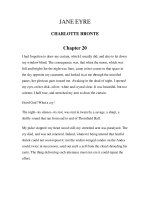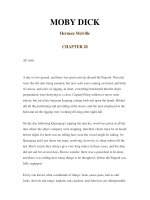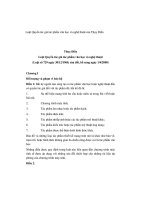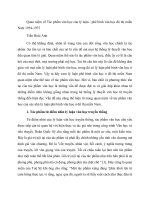tác phẩm văn học của tác giả Jules verne 20 000 leagues under the sea
Bạn đang xem bản rút gọn của tài liệu. Xem và tải ngay bản đầy đủ của tài liệu tại đây (2.09 MB, 114 trang )
CALICO
Jules Verne’s
CLASSICS
20,000 Leagues
Under the Sea
A DA P T E D BY :
Jan Fields
I L L U ST R AT E D BY :
Eric Scott Fisher
Invisible Man.indd 1
11/22/10 11:47 AM
CALICO
Jules Verne’s
CLASSICS
20,000 Leagues
Under the Sea
Adapted by: Jan Fields
Illustrated by: Eric Scott Fisher
visit us at www.abdopublishing.com
Published by Magic Wagon, a division of the ABDO Group,
8000 West 78th Street, Edina, Minnesota 55439. Copyright
© 2011 by Abdo Consulting Group, Inc. International copyrights
reserved in all countries. All rights reserved. No part of this
book may be reproduced in any form without written permission
from the publisher.
Calico Chapter Books™ is a trademark and logo of Magic Wagon.
Printed in the United States of America, Melrose Park, Illinois.
102010
012011
This book contains at least 10% recycled materials.
Original text by Jules Verne
Adapted by Jan Fields
Illustrated by Eric Scott Fisher
Edited by Stephanie Hedlund and Rochelle Baltzer
Cover and interior design by Abbey Fitzgerald
Library of Congress Cataloging-in-Publication Data
Fields, Jan.
20,000 leagues under the sea / Jules Verne ; adapted by Jan Fields ;
illustrated by Eric Scott Fisher.
p. cm. -- (Calico illustrated classics)
ISBN 978-1-61641-110-7
[1. Sea stories. 2. Submarines (Ships)--Fiction. 3. Science fiction.] I.
Fisher, Eric Scott, ill. II. Verne, Jules, 1828-1905. Vingt mille lieues
sous les mers. III. Title. IV. Title: Twenty thousand leagues under the
sea.
PZ7.F479177Aap 2010
[Fic]--dc22
2010030857
Table of Contents
CHAPTER 1: A Shifting Reef . . . . . . . . . . . . . . . . . . . 4
CHAPTER 2: At Full Speed . . . . . . . . . . . . . . . . . . 10
CHAPTER 3: Ned Land’s Tempers . . . . . . . . . . . . 16
CHAPTER 4: Some Figures . . . . . . . . . . . . . . . . . . . 21
CHAPTER 5: The Man of the Seas . . . . . . . . . . . . 26
CHAPTER 6: All by Electricity. . . . . . . . . . . . . . . . 33
CHAPTER 7: A Note of Invitation . . . . . . . . . . . . 41
CHAPTER 8: A Walk . . . . . . . . . . . . . . . . . . . . . . . . . 50
CHAPTER 9: A Few Days on Land . . . . . . . . . . . 55
CHAPTER 10: The Indian Ocean . . . . . . . . . . . . . 62
CHAPTER 11: A Pearl of Ten Millions . . . . . . . . 69
CHAPTER 12: The Arabian Tunnel . . . . . . . . . . . 77
CHAPTER 13: The South Pole . . . . . . . . . . . . . . . . 86
CHAPTER 14: Want of Air . . . . . . . . . . . . . . . . . . . 92
CHAPTER 15: Giant Squid . . . . . . . . . . . . . . . . . . . 97
CHAPTER 16: A Hecatomb . . . . . . . . . . . . . . . . . 102
CHAPTER 17: The Last Words
of Captain Nemo
..........................
108
1
A Shifting Reef
The year 1866 was marked by strange
events at sea. Several ships met with a long,
glowing object of enormous size. The thing
moved incredibly fast and had no set migration
or patch of ocean in which to dwell.
It might have been allowed to exist in peace
had it not done the one unforgivable thing—it
endangered ships. And specifically it damaged
a ship owned by the famous English shipowner
Cunard.
In April 1867, the Scotia was struck by
something that pierced its hull with a neat
hole in the shape of a perfect triangle. The
ship limped home safely, but the damage was
enough to bring about the public outcry to rid
the seas of this mysterious creature.
4
At this time, I was in the United States. The
French government had asked me to join an
expedition to the Badlands of Nebraska. This
was because I was an assistant professor at the
Museum of Natural History in Paris. By the
end of March, I was in New York packing for
my return to Paris.
I was familiar with the stories of the
mysterious sea creature. They filled every
newspaper. Some said the creature was really
floating debris from a wreck or a floating reef.
But that hardly explained the high speeds some
witnessed.
Some said it was some kind of underwater
boat, but how could any country create such
an amazing craft in complete secrecy? And to
what purpose?
Each country was questioned, of course. But
every government seemed equally concerned
about this dangerous situation.
During my stay in New York, several people
consulted me on the subject. Finally, I did
5
share my opinion with the New York Herald. I
considered each theory and responded to it.
Finally, I admitted that I believed the creature
was a giant narwhal. The narwhal can grow
to sixty feet and has a long tusk that has been
known to pierce the sides of wooden ships. I
believed we were seeing a species ten times the
normal size.
My theory was hotly debated, but I heard
no better ideas presented. I admit my theory
added fuel to the “monster hunters.” They
insisted the creature be tracked down and
eliminated.
The United States planned a mission to hunt
the narwhal. The fast frigate, the Abraham
Lincoln, was called to fulfill the mission with
Commander Farragut in charge.
Three hours before the Abraham Lincoln
was due to leave its pier in Brooklyn, I received
the following letter:
6
7
Pierre Aronnax
Professor of the Paris Museum
Fifth Avenue Hotel, New York
Dear Sir,
If you would like to join the expedition of the
Abraham Lincoln, the government of the United
States would take great pleasure in having you
represent France on this mission.
Cordially yours,
J.B. Hobson
Secretary of the Navy
Though I had given no thought to chasing
the narwhal, I decided at once that I must go.
I called my servant and assistant, Conseil, and
told him we had two hours to prepare and reach
the ship. He agreed with complete calm, only
asking what to do with my many collections.
“The hotel will keep them for us,” I assured
him.
“Whatever suits Monsieur,” he said.
8
We arrived at the Abraham Lincoln as it
was preparing to leave. Commander Farragut
welcomed me in person and I was quickly taken
to my cabin, which I found pleasant. We then
left port as crowds cheered from the wharves
lining the East River.
9
2
At Full Speed
Commander Farragut had sworn to get rid
of the giant narwhal, and no other course was
acceptable. He promised $2,000 to the first
man to spot the whale. This guaranteed the
enthusiasm of virtually every man aboard.
The ship was outfitted with hand-thrown
harpoons, blunderbusses that shot out barbed
arrows, and swivel guns with exploding shells.
On the forecastle stood a cannon.
With all this weaponry onboard, the ship had
something even better—the best harpooner in
the world. Ned Land had skill, courage, and
coolness. No whale was likely to escape him.
Land was a tall, powerfully built Canadian.
He could be hot tempered, but he took a
10
special liking to me, as he enjoyed conversing
in French. He also did not believe in the giant
narwhal.
“I’ve hunted hundreds of whales,” he said.
“But none could crack the steel plates of a
steamer, not with tails nor tusks.”
“But we know narwhals have pierced the
sides of ships,” I argued.
“Wooden ships,” the Canadian said.
“But if the whale doesn’t exist,” I said. “How
do you explain what happened to the Scotia?”
Land had no answer but still doubted the
giant narwhal’s existence. I believed he would
soon find reason to change his mind.
For months, the Abraham Lincoln cruised
down the Atlantic coast of South America and
on to the Pacific. We found nothing but water.
Finally, the crew’s enthusiasm waned. No one
spoke of mutiny, of course. Still, Commander
Farragut felt the crew’s mood.
11
On November 2, he promised to look just
three more days. If nothing was spotted, we
would head for European waters and then
home.
The three days passed and Commander
Farragut changed course. On that night, I stood
at the rail and looked across the water. Conseil
stood at my side, as he always did.
“This was a foolish venture,” I said sadly. “I
expect people will laugh at my theory now.”
“Yes,” Conseil answered calmly. “People
will laugh at Monsieur, and Monsieur will be
getting what he deserves.”
“Really?”
“An honored scientist like Monsieur does
not get mixed up in . . .”
But Conseil did not get the chance to finish
scolding me, for Land’s voice rang out. “Ahoy!
There it is!”
And so it was at a distance of about 400
yards off the starboard quarter. There could be
no mistake about it. The creature was several
12
fathoms below the surface, giving off a huge
oval-shaped glow.
Then the creature began moving toward us.
The frigate moved rapidly away. Or rather, it
tried to move away, but the creature moved at
double the speed of the ship. The creature did
a complete circle around us, then moved off
about two or three miles.
Suddenly, it rushed headlong toward the
Abraham Lincoln at a terrifying speed. It dove
beneath us and came up on the other side.
“Get up more speed if you can,” Land
suggested. “I’ll take up position in the bowsprit.
If we can get near enough, I’ll harpoon it.”
The commander called out, “Build up more
pressure.”
The Abraham Lincoln reached an unheard
of speed of 18.5 knots, but the creature simply
traveled at the same rate and allowed not one
inch of gain.
More coal was shoveled into the boilers.
Our speed reached 19.3 knots. We were in real
13
danger of blowing up, but we still could not
catch the creature.
Finally the commander called for the best
gunner to man the forward cannon. The shell
reached its target but only glanced off. Then
the creature glided slowly toward us.
I leaned over the forward rail and could
see Land below me. He was hanging onto the
rigging and clutching his terrible harpoon.
14
When scarcely twenty feet remained
between him and the creature, he threw the
harpoon. I heard a ringing noise as the harpoon
struck something hard. Then the light went
out and two enormous streams of water broke
over the deck of the frigate. It rushed from
stem to stern.
There was a terrible crash. I was hurled
overboard and into the sea.
15
3
Ned Land’s Tempers
At first, I was dragged down to a depth of
about twenty feet. I am a good swimmer and
I did not panic. Two strong kicks brought me
back to the surface.
My first thought was the frigate. Did I have
any chance of being saved? In the darkness, I
could make out the vague black shape of the
ship slowly fading as it got farther away. I was
done for.
My wet clothes weighed down my body. I
was sinking. I shouted for help and my mouth
filled with water. Suddenly a powerful hand
grabbed me, and I was pulled to the surface.
“If Monsieur would lean on my shoulder,
Monsieur would be able to swim more
comfortably.”
16
I seized the arm of my faithful Conseil. “Did
the crash throw you into the water along with
me?” I asked.
“Not at all. I followed Monsieur.”
“And the frigate?” I asked.
Conseil rolled over on his back. “I think
Monsieur would be wise not to count on that
too much. When I was getting ready to jump
into the water, I heard men shouting that the
propeller and rudder were broken.”
“That means we’re done for!”
“Nevertheless, we still have several hours,”
Conseil answered calmly. “And one can do
many things in several hours.”
Conseil’s unshakable coolness gave me
courage. Conseil used a knife he carried to cut
my clothes from me, and then I did the same for
him. We could swim more comfortably now.
We decided to take turns swimming in the
direction of the frigate. One man would relax
completely while the other towed him and
swam. We swam this way for several hours.
17
Finally, the moon appeared over the edge of
a large cloud and we were able to see more
clearly. I caught sight of the frigate. It was over
five miles away. I was too exhausted to make a
sound, but Conseil shouted for help.
It seemed as if I heard someone answer his
shout. Conseil shouted again and this time
there could be no doubt about it. A human
voice was answering ours.
Conseil pushed me along until something
hard knocked against me. I grabbed onto it. I
felt something dragging me, and I passed out.
I opened my eyes to the fading light of the
moon sinking down toward the horizon. I
made out a face that wasn’t Conseil’s but that
I immediately recognized.
“Ned!” I cried.
“Yes, it’s me, still chasing my prize,” the
Canadian answered.
“Were you thrown into the sea by the
collision?” I asked.
18
“Yes,” he said. “But I was able to catch a
ride on our monster. I can see now why my
harpoon couldn’t do any damage. This critter
is covered in steel plates.”
In shock, I felt beneath me and my hand
rested on bolted down plates. This monster
was the work of man.
“This thing must have some form of crew,”
I said.
“Obviously,” replied the harpooner. “But
I’ve been on this thing for three hours and have
seen no sign of life.”
“It hasn’t moved?”
“We know it’s capable of great speed. It must
have a crew.” Just then, there was a swirling in
the water to the rear of the strange thing and
it began moving. We got a good hold of its top
side and rode along.
“As long as it stays on the surface,” Land
murmured. “We should be all right.”
We knew the ship could dive. So it was
urgent that we communicate with its crew. I
19
tried to find some opening or hatch, but found
only smooth plate.
Toward four in the morning, the ship picked
up speed. It became difficult to hang on.
Luckily, Land found a large mooring ring and
we were able to get a firm hold on it.
Finally dawn came. With it, the ship began
to sink slowly. Ned Land pounded the steel
plates with the heel of his boot.
“Confound it,” he shouted. “Open up!”
A loud clanking rang from inside the
submarine. One of the plates rose up and a
man appeared. He cried out and quickly
disappeared. Then eight young men with
masked faces came out on deck and dragged us
inside.
20
4
Some Figures
When the hatch closed behind us, I was
surrounded by total darkness. I could feel a
ladder under my feet. At the bottom of the
ladder, we were hauled into a room. A steel
door slammed, closing us into the total darkness.
Land raged around the room in a fury. “Calm
down, Ned,” Conseil urged. “We must think
calmly.”
“Well, I’ve still got my bowie knife and I
know how to use it,” Land shouted.
As they spoke, I felt around in the dark. The
bare walls were without doors or windows and
a thick linen mat covered the floor. I walked
into a wooden table surrounded by stools but
found nothing else.
21
About half an hour after being tossed into
the room, a blinding light came on from an
electric bulb in the ceiling.
“Finally!” said Land, who stood with his
knife in hand. “We can see.”
“But we are still in the dark,” I muttered.
The light allowed me to see the small room
but showed nothing interesting. From within
it, I could not even tell if the submarine was
moving. Still, the sudden light suggested to me
that we might soon be visited.
We heard bolts drawn and the door opened
to show two men. One of the men was short
but powerfully built with broad shoulders and
a large head. He wore a big mustache.
The other man had pale skin and a calm
confidence. He was tall with splendid teeth
and piercing, wide-set eyes. Both men wore
otter-skin caps and seal-skin boots. The tall
man looked each of us over and then spoke in
some deep language that I didn’t recognize.
22
The other man nodded in response and
answered in equally incomprehensible words.
Then the shorter man looked at me. I told him
in French that I did not speak his language. He
looked puzzled.
“Monsieur should tell them our story
anyway,” Conseil whispered.
“They may
understand some words.”
And so I did, speaking carefully and not
omitting a single detail. I then formally
presented each of us by name.
23









